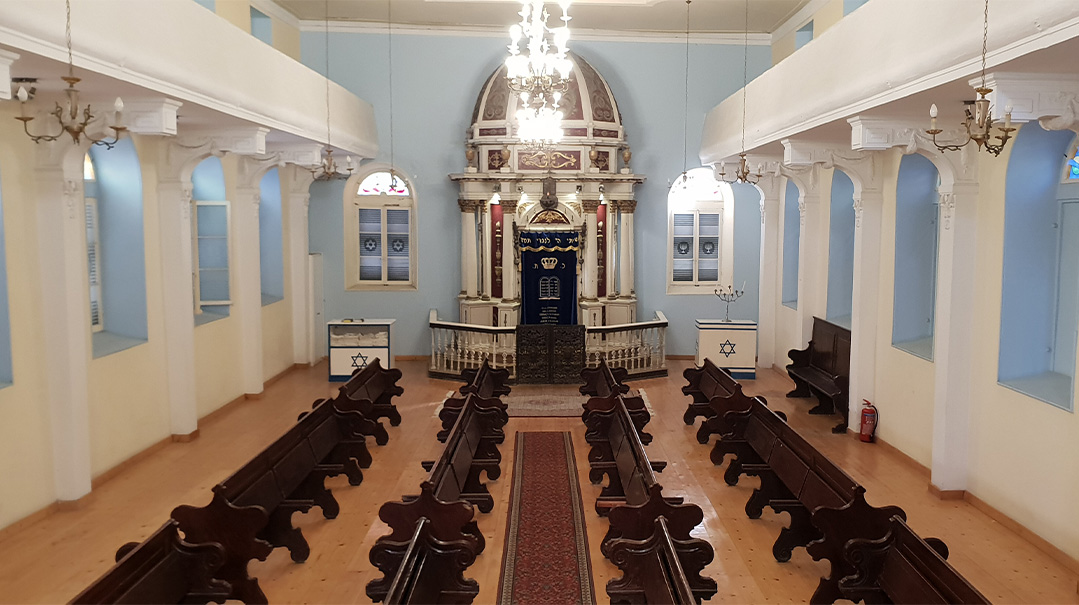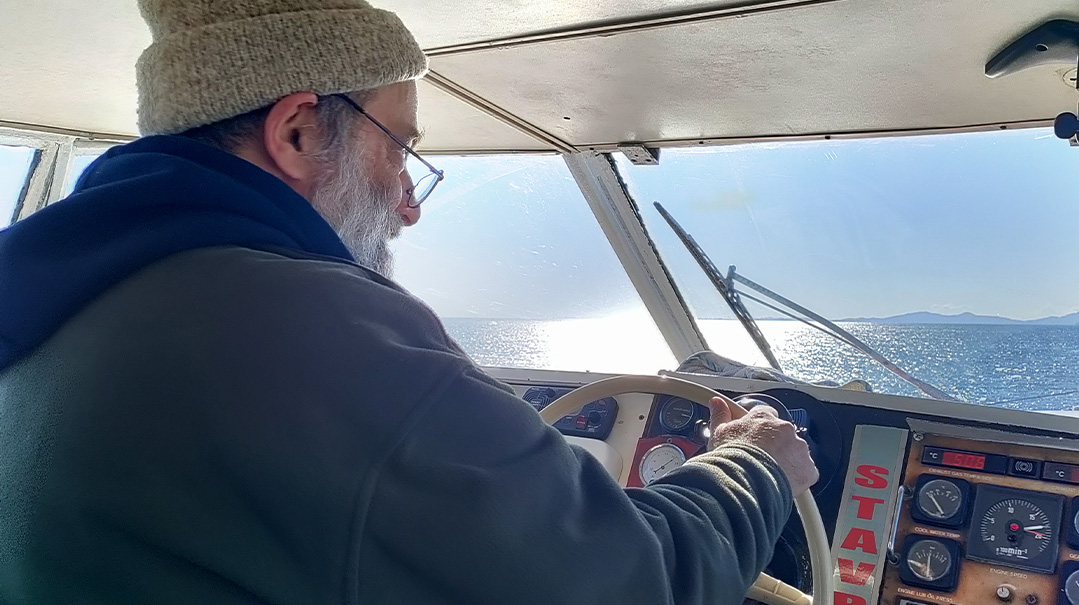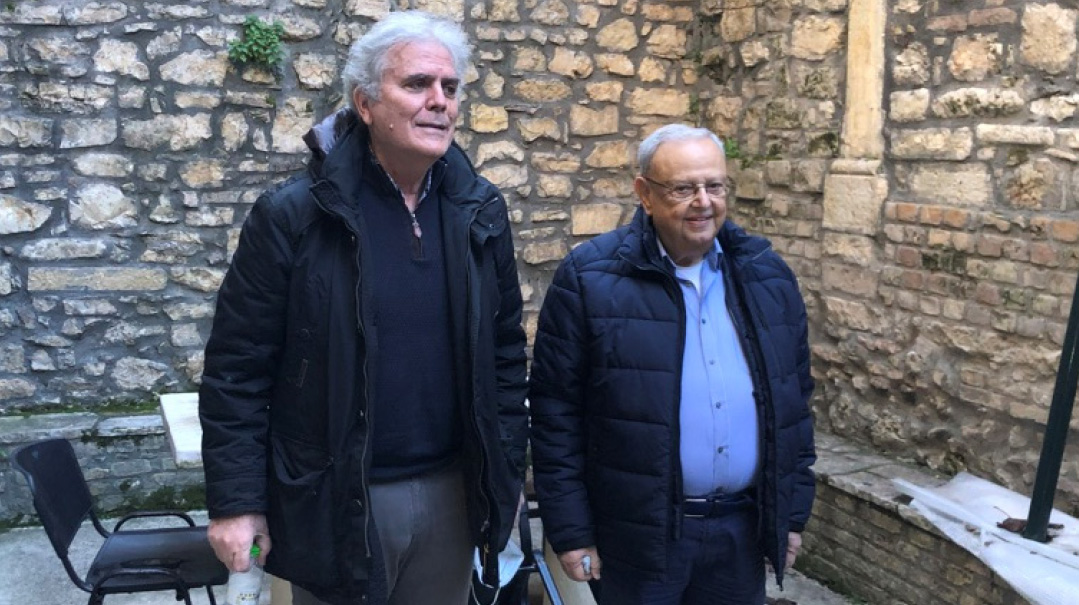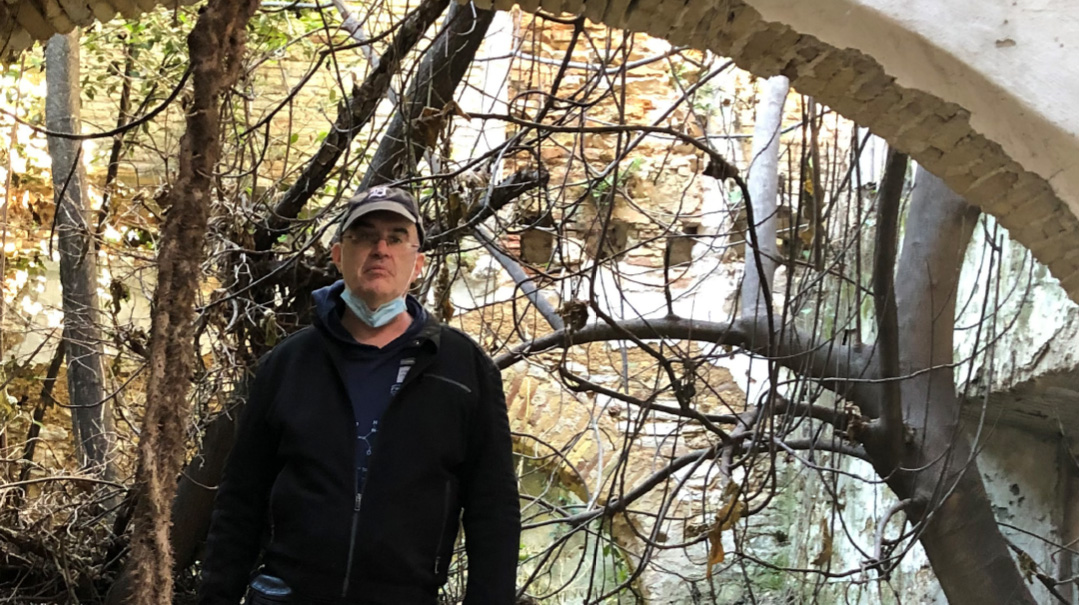Treasured Island
| June 21, 2022Ari and Ari explore the ancient esrog kingdom of Corfu

Photos: Ari Z. Zivotofsky and Ari Greenspan
The ancient Greek island mythologically connected to Poseidon, god of the sea, wasn’t only a home for Greek deities. This Mediterranean haven that once boasted a vibrant community and prominent rabbis and grew sought-after esrogim now has a small, dwindling kehillah that is struggling to survive. Today, Corfu — a small island lying just off the coast at the border of Albania and Greece in the Ionian Sea, a projection of the north Mediterranean — is part of the club of those once great Jewish communities.
The island was a center of trade and commerce throughout history and had a glorious past of great rabbis and a diverse Jewish population. It was also the epicenter of the great esrog wars of the 19th and early 20th centuries that dominated the esrog market with accusations of grafted esrogim (and of course, that interested us and was ripe for halachic exploration). As we were in Albania to do a bris milah, we took the opportunity to visit the few remaining Jews of nearby Corfu. It is just a short half-hour boat ride from southern Albania, and although we had to cut through some choppy waves, the captain even permitted us to pilot the 200-seat vessel for part of the journey.
The island of Corfu is approximately four times the size of modern Jerusalem, with a total population of about 100,000 people. When the famed Jewish traveler Benjamin of Tudela visited in the 12th century, he found only one Jew living there, working in the lowly trade of a dyer. Ambling through its old city, we noted that many buildings appear to be hundreds of years old, scores of which are now sealed up and crumbling, many of them abandoned. Our goal, as usual, was to speak to any remaining Jews, to find the shuls and the Jewish ghetto, and see if we could uncover the real history of this once-Jewish bastion. The chief rabbi of Greece put us in touch with some of the last members of the community and we arranged to meet them in the sole remaining shul.
Sometimes visits like these are depressing, but they can often be inspiring as well. There is a certain tenacity and grit we’ve found while exploring barely-surviving communities, and we wondered if we’d find it here among the mementos of a kehillah that’s barely hanging on for survival.

We were just a half hour away from Albania by boat, which the captain even let us pilot. How could we not pop onto the island of Corfu and give the remaining local Jews a little chizuk?
Questions and More Questions
Traveling during the Covid pandemic has been challenging, and passing through multiple borders even more so. You never really know what the rules are, as requirements change quickly and information sources are not always updated. We decided to try and eliminate all chances and took a PCR test, the gold standard, in Albania the day before we were scheduled to reach Corfu, and we received the hoped-for negative results. We boarded the boat, and 30 minutes later arrived in Corfu. Waiting in line at border control at the port, they were randomly testing some of the disembarking travelers. Armed with our vaccination certificate and recent PCR result, we were still anxious as they selected one of us for a random test — and we envisioned being stuck on this island in a room with no kosher food and no one to help us. Thankfully, we didn’t pick up Covid in the prior 24 hours.
We had arranged to be at the old shul an hour after landing, and made our way through the empty winding narrow alleys, coming to a large, beautiful yellow building with discreet Magen Davids adorning it. Waiting for us inside were the community president, Zacharias Matathias, and the former president Lino Soussis, along with their wives and a few other members. They were a congenial, affable group, and we spoke in a mix of English, Hebrew, and Italian. The Italians dominated Corfu at different points of history, and many people still speak Italian.

Community president Zacharias Matathias and former president Lino Soussis, in the shul’s hidden courtyard succah. They both know what it means to start life again
Lino, a short, pleasant man with a quick smile, began to tell us about Jewish life on the island, whose modern history is essentially dominated by the Holocaust. In April 1941 Italy took control of Corfu and for the next year and a half, the Jews were still safe. But when the Germans occupied the island in September 1943, the 2,000 Jews (down from a high of about 5,000 in 1890) — approximately two-thirds of whom were Italian and one-third Romaniote — were in immediate danger. Their valuables and keys were taken, and within a short time their houses were ransacked. About 200 Jews managed to hide with neighbors while the remainder were rounded up and imprisoned in the “Old Fort,” an imposing large brick structure dominating the shoreline, that once housed the British army barracks and today is used as a public library.
Today the quiet, quaint old neighborhood that includes the Old Fort is so serene that as we strolled the area one evening, it was difficult to conjure up images of the terror of that short period of imprisonment before the Jews were loaded onto barges and taken to mainland Greece. There, they were put onto cattle cars and sent by rail to Auschwitz. By the end of the arduous journey with no food or water, half were dead on arrival and the rest went straight to the gas chambers. Just like that, one of the oldest Jewish communities in Greece was extinguished. After the war, about 180 survivors returned home, to the place where their families had been for generations — yet it was a Jewish ghost town, save for the few Jews that had been hidden and survived the deportation.
Lino looked at us and said, “I don’t understand how G-d could have done this.” He continued, “I thought I knew my grandparents, but they must have been full of sin for G-d to have killed them.” Not really sure how to answer, but feeling a need to respond, Ari G. gently disagreed with him. “I don’t think you can look at the Holocaust as being due to the sins of those who perished. Do you really think your sweet old grandmother was full of sin? I doubt it. We can’t always fathom the ways of G-d.” We were left with an uncomfortable silence, but Lino snapped right back into narration mode and continued to describe how most of the people who returned married or remarried and started families. He and Zacharias were both born in the late 40s to survivors. Zacharias’ father had been previously married but his wife was killed. When he returned home, broken and despairing, he picked himself up, remarried, and started life again.

Ancient wooded support beams and an out-of-service mikveh are the current makeup of the shul’s basement (left); jumping into the crawl space under the aron kodesh, we discovered a genizah treasure
Out of the Darkness
The “Nuova” or “New” synagogue, the only synagogue that survived World War II, was built when the Jews were forced to leave the old Romaniote Scuola Greco Synagogue during the British rule after Napoleon was defeated in the early 19th century. The pretty yellow stucco building façade doesn’t draw attention, the building keeping a low profile save for a modern Hebrew plaque and a small Magen David above the door. Because no other Jewish signs or symbols exist, the sanctuary hidden inside comes as a surprise to the visitor. Even the succah is concealed behind its walls. While a large communal room is on the ground floor, on the right of the small entrance anteroom is the access to the synagogue two flights up — an aesthetic sanctuary with light blue interior walls, hanging chandeliers and a pristine wooden floor. The old Italian-style aron kodesh with a cupola housing some beautiful ancient sifrei Torah is on one end of the sanctuary, with a bimah on the other.
We noticed what appeared to be a small door below the aron kodesh and opened it. It revealed a crawl space into which we jumped and there found a genizah. There were old seforim, some going back to the 1700s, but what especially caught our eye was a small pile of thin paperback books held together by some string. They looked like the type of things that would normally be thrown into a modern genizah, but seemed out of place among the piles of old books.
We pulled it out and found a hidden treasure of Jewish history. After WW II, seforim were not to be found in Europe — it was said that not one complete Shas was left. Realizing that the emotional healing of frum Jews was dependent on learning and davening, the American Joint Distribution Committee (JDC) started a project to reprint the Shas and basic religious books such as siddurim and Chumashim. Among the myriad problems with that initiative was a shortage of paper and printing presses, but with the assistance of the US Army, they were able to print essential seforim and 1,000 copies of Shas. The “US Army Talmud” has a unique inscription: “Published by the Agudat Harabbanim with the help of the US Army in the American Zone in Europe and the Joint.”
The little package we had in our hands is an unknown printing of Chumashim by the same press. It was printed in the American section of Germany for “the remnant of the Jewish people… by the Jewish Agency and the Joint” in Munich, 1948. One can only imagine how the 180 returning Corfu Jews felt when they held these Chumashim, with their front-page drawing of Jews in a barbed wire death camp going to Eretz Yisrael, and finally, the rising sun over Jerusalem. The text reads, “From bondage to freedom, from darkness to a great light.”
As shul basements are often treasure founts, we climbed down to the basement of the shul, which is currently being shored up. The ancient wooden support beams were exposed, along with a mikveh that appears to have not been used for a few years.
There is an abandoned Jewish school building adjacent to the shul that was once reachable by going through the internal open aired space used for the succah. Today it looked like a post-apocalyptic vision. The walls of the large two-story building were crumbling yet standing, but the roof had collapsed inside and trees and bushes were growing in the interior. We walked around the building and found a partially opened door, and managed to squeeze through into what looked like a small forest. We stood on a mound of dirt that almost reached the second floor. Peering around, we tried to conjure up the voices of kids learning, of a beis medrash where Gemara was once studied, of bar mitzvah boys learning their parshah — all now lost in the new growth of an impenetrable forest.
Save the Date
The last pre-war kesubah written on the island is an important remnant of a community attached to its history and dreaming of a better future. Most Jewish documents today are dated from Creation (this year being 5782), while the older system of dating from the Churban Beis Hamikdash went out of use long ago. However, Jews of the Romaniote rite continued to use this system, as indicated on the last Corfu kesubah (currently in the JTS library), which is dated “Friday, the 4th of Sivan, 5704 to Creation, and 1876 to the destruction of the Beis Hamikdash, may it be built speedily in our days and the days of all of Israel, amen, according to the dating system we are accustomed to use here, the city of Corfu.” That date corresponds to May 26, 1944, just two weeks before the June 9 order rounding up all the Jews of Corfu for deportation and death.

The abandoned school building adjacent to the shul is now not much more than a collapsed roof and an interior of trees and bushes
Not Afraid of Controversy
There have been Jews on Corfu since at least the 12th century, and during the 13th and 14th centuries there was an influx of Romaniote Jews, the original Jews who’d lived in Greece for over 2,300 years. They developed their own Jewish language called Yevaniak, much like the Yiddish of Ashkenazim or Ladino of Sephardim.
As we walked the quiet alleyways, some named after prominent Jews, the only apparent excitement was that surrounding Covid, evident in advertisements for stores selling home-testing kits and signs about wearing masks. But for us, we were transported to some of the halachic storms that had emanated from these very alleyways. One of the prominent players was Rav David HaCohen, who was born in 1465 on Corfu and died in Adrianople (Edirne), Turkey, in 1530. He studied in a yeshivah that existed on the island and later went to Italy to study with gedolim. He returned to Corfu to serve as its rabbi and to run the local yeshivah, and was known as the Radach of Corfu.
As Corfu was situated between Italy and Turkey, many Spanish Jews fleeing the Inquisition found themselves in Corfu for a while on their way to Turkey. The Radach’s extensive knowledge found expression in his responsa, many of which dealt with the Anusim of Spain. Unfortunately, most of his writings went up in smoke during a fire. The Radach is best known for a huge agunah controversy. In 1521 Rabbi Benjamin Zev in Greece had permitted an agunah to remarry based on the testimony of a non-Jew. Shortly thereafter chaos ensued, with Rav David HaCohen of Corfu among those who sharply criticized this decision. In another teshuvah, he was asked about a son wanting to say Kaddish for his father, who was a converso and was murdered by thieves. Other mourners argued they have precedence in saying Kaddish for the congregation, because the murdered man was an apostate. The Radach of Corfu, however, stated that the man was still a Jew and the son’s Kaddish is doubly important for the deceased’s soul. And among his more “contemporarily relevant” responsa, he discussed sheitels in the 16th century and said they were allowed only if covered.
Rav Don Isaac Abarbanel, having been an advisor first to King Afonso V of Portugal and later to Queen Isabella I of Castile, was offered a personal exemption to the expulsion of the Jews. Still, he chose to leave Spain with his co-religionists during the Spanish expulsion, ultimately finding himself in Naples, Italy where he became an advisor to the king. When the French invaded and took Naples, he was once again forced to flee, this time losing all his great wealth. Bereft of his property, in 1495 he spent a short time in Corfu before settling permanently in Venice. It was during this respite from government service that he spent time on his religious writings, initiating an intense effort to write his commentaries. His commentary on Yeshayahu was actually started while he was on Corfu.
Another colorful Corfu character was Gibraltar-born, Livorno-educated polyglot and physician, Rabbi Yehudah Bibas, who was appointed chief rabbi of Corfu in 1831, when he was 40 years old. Rabbi Bibas was one of the earliest ardent proto-Zionists. His vision was shared with communities all over Europe, encouraging Jews to move to Palestine and with the expectation that when enough arrived, they would conquer it from the Turks to create a Jewish State. He moved to Chevron in 1852 after his wife passed away, died two months later, and is buried there.
The Great Esrog Wars
Today, getting a beautiful esrog is taken for granted, no matter where you live. Esrogim are shipped around the world and are easily attainable, not like in previous years when many communities had just one or two esrogim and the entire kehillah had to make a brachah on them. In the premodern world, and in northern Europe in particular where the cold weather precluded the esrog from growing, all the esrogim had to be shipped and then transported by boat or horse and wagon to each little shtetl. The great sums of money that could be made by the rare and exotic fruits made for a very competitive business.
Non-Jewish fruit growers around the Mediterranean basin, primarily in north-western Africa, Italy, and Greece were the main suppliers of esrogim to the Jewish Diaspora. Each area had its unique esrogim, with minor differences in size and shape. Corfu was known for its exceptionally gorgeous esrogim, which were often the esrog of choice due to their beauty.
In the early 19th century, esrogim in Europe came primarily from the Italian and Greek regions of the Mediterranean. The “Calabria” esrogim, grown on the southern Italian coast in the region of Calabria, had a long tradition of non-grafted pedigree, going all the way back to Rashi, according to the Chasam Sofer and others. These, and other Italian and Greek esrogim, were brought to Italy, either to Trieste on the eastern coast or Genoa (“Yanover” in Yiddish, therefore sometimes referred to as “Yanover” esrogim) on the western side, and trans-shipped to the rest of Europe.
One problem that esrog growers face, and that haunts all esrog buyers even today, is that a “murkav” or grafted esrog is not halachically acceptable. The esrog tree is a naturally weak tree and thus growers sometimes graft the fragile esrog tree onto a heartier “bitter orange” rootstock. However, there is no way to verify if a tree was grafted by just looking at the fruit, but only by examining the base of the actual tree trunk. But how would anyone in Eastern Europe be able to do that? In 1846, Rabbi Ziskind Mintz of Brody in Poland, who earned his livelihood from selling esrogim, dominated the local Galicia esrog market with esrogim from Parga on the Greek mainland, and the local rabbis announced that only his were kosher and that the others, from Corfu, were grafted fruits and forbidden to be used. Their proof: The Corfu esrogim were so beautiful and had such a hearty pitom that they must be grafted because no natural esrog could be so perfect. A war of words erupted and nearly every European posek issued an opinion regarding the acceptability of the stunning Corfu esrogim. The arguments found their voice in halachic journals and newspapers of the time. Meanwhile, the non-Jewish esrog growers of Corfu created a cartel to control the prices. Thinking that they were indispensable to the Jews, they raised the price of the Corfu esrogim drastically. This led additional rabbanim all across Europe to forbid the use of these esrogim, even though Chief Rabbi Bibas himself gave the hashgachah on the Corfu fruits, verifying their non-grafted status and determining that grafting in the Corfu climate was actually detrimental to the esrog. Still, Corfu tensions simmered as their esrog sales diminished, and when protests against the Corfu esrogim escalated, the Greek growers dumped thousands of the fruits into the ocean in fury — and thinking that the shortage would further drive up the prices.
Several years later, a new factor came into play for the Corfu esrog market: the Corfu blood libel of 1891. When it was over, a dozen Jews were dead, along with the Corfu esrog trade forever. A world-wide outrage was awakened against Corfu and its esrogim, with a simultaneous push by Rav Kook to purchase the esrogim from the Land of Israel in his 1907 book Pri Etz Hadar.
In Eretz Yisrael, the Sdei Chemed took it as a given that Corfu esrogim were murkav and that a person who uses them makes a brachah levatalah. He took the opportunity while discussing Corfu esrogim to quote a letter that he received from Rav Yechiel Michel Epstein, the author of the Aruch haShulchan, shortly after Pesach 1896 in which Rav Epstein uses flowery language and word plays from pesukim to criticize one who prefers the “fruit of the hated over the esrog of the beloved,” referring to using esrogim from the diaspora instead of those from the Land of Israel. He goes so far as to say, “Woe to the honor of Hashem, woe to the honor of the holy Torah which contains many pesukim in praise of the Land of Israel. Woe to the honor of Moshe Rabbeinu who pleaded to enter and see the Land, and how different are these people from the Talmudic sages who rolled in the dirt of the Land and kissed its stones but rather they roll in the dirt of foreign lands and kiss its fruit and reject the fruit and the goodness of the Holy Land like an unwanted vessel.”
Despite this history, we found some photographs of esrogim on the walls of the shul, and we asked if there were any of the original groves left. They told us no, but that they had recently discovered one grower of esrogim on the island. Interestingly, we learned that just across the channel in southern Albania, esrogim are widely grown, but all for local use and not for export to Jews.
Corfu is a sad place for Jews today. Once a vibrant and ancient community of Sephardi, Italian, and Romaniote Jews, its tiny kehillah now lives completely in the shadow of the Holocaust, and the last Corfu-born Jews are seeing their legacy pass away before their eyes. They simply did not have a critical mass, and the younger generation has moved elsewhere, such that there is no one to continue the legacy. In the words of the president of the Jewish community, “We are on our last legs.” Unfortunately, it looks like he’s correct, but still, we’re thankful for the opportunity to experience this noble island and the Jewish community hanging on by a thread.
(Originally featured in Mishpacha, Issue 916)
Oops! We could not locate your form.







